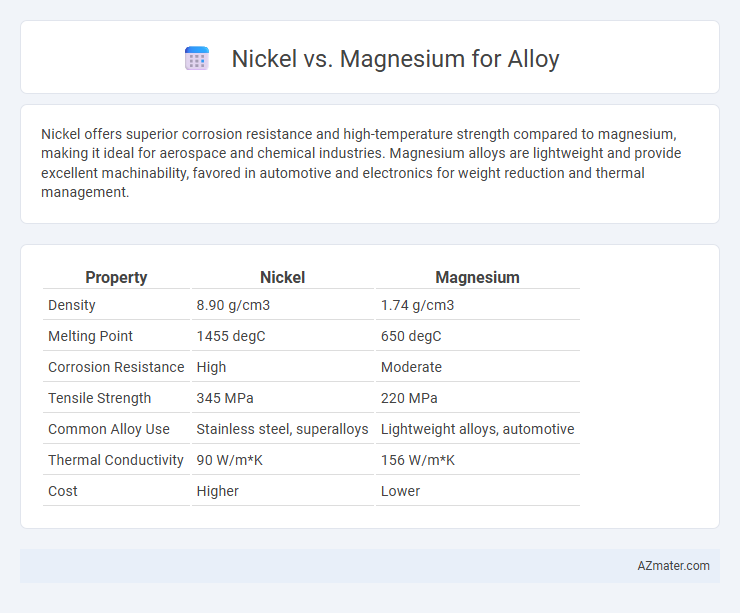Nickel offers superior corrosion resistance and high-temperature strength compared to magnesium, making it ideal for aerospace and chemical industries. Magnesium alloys are lightweight and provide excellent machinability, favored in automotive and electronics for weight reduction and thermal management.
Table of Comparison
| Property | Nickel | Magnesium |
|---|---|---|
| Density | 8.90 g/cm3 | 1.74 g/cm3 |
| Melting Point | 1455 degC | 650 degC |
| Corrosion Resistance | High | Moderate |
| Tensile Strength | 345 MPa | 220 MPa |
| Common Alloy Use | Stainless steel, superalloys | Lightweight alloys, automotive |
| Thermal Conductivity | 90 W/m*K | 156 W/m*K |
| Cost | Higher | Lower |
Introduction to Alloying Elements: Nickel and Magnesium
Nickel and magnesium serve as critical alloying elements, each contributing distinct properties to metal composites. Nickel enhances corrosion resistance, toughness, and high-temperature strength, making it invaluable in stainless steels and superalloys. Magnesium, characterized by its low density and high strength-to-weight ratio, is essential for lightweight alloys used in aerospace and automotive applications.
Physical Properties: Nickel vs Magnesium
Nickel offers superior corrosion resistance and higher melting point (1455degC) compared to magnesium's lower melting point (650degC) and moderate corrosion resistance, making nickel alloys ideal for high-temperature and harsh environments. Magnesium's low density (1.74 g/cm3) is significantly lighter than nickel's density (8.9 g/cm3), providing enhanced strength-to-weight ratio critical for aerospace and automotive applications. Thermal conductivity is higher in magnesium (156 W/m*K) than in nickel (90.9 W/m*K), affecting heat dissipation in alloy selection.
Chemical Behavior in Alloys
Nickel exhibits excellent chemical stability and corrosion resistance in alloys, enhancing their strength and durability, especially in stainless steels and superalloys. Magnesium, known for its lightweight properties, tends to be more reactive and susceptible to oxidation, which requires alloying with elements like aluminum or zinc to improve corrosion resistance and mechanical performance. The distinct chemical behaviors influence their alloy applications, with nickel alloys favored for high-temperature and corrosive environments, while magnesium alloys are primarily used where weight reduction is critical.
Strength and Durability Comparison
Nickel alloys exhibit superior strength and corrosion resistance compared to magnesium alloys, making them ideal for high-stress and high-temperature applications such as aerospace and chemical processing. Magnesium alloys offer a lightweight advantage but generally have lower tensile strength and are more prone to fatigue and environmental degradation. The enhanced durability of nickel alloys results from their excellent resistance to oxidation and mechanical wear, extending lifespan in demanding environments.
Corrosion Resistance Capabilities
Nickel alloys exhibit superior corrosion resistance compared to magnesium alloys, especially in harsh environments such as marine and chemical processing settings. Nickel's ability to form a stable, protective oxide layer enables it to withstand oxidation and pitting corrosion far better than magnesium, which is prone to rapid corrosion in moist or acidic conditions. As a result, nickel-based alloys are preferred for applications requiring long-term durability and resistance to aggressive chemical exposure.
Weight and Density Considerations
Nickel alloys typically exhibit higher density, around 8.9 g/cm3, compared to magnesium alloys, which have a significantly lower density near 1.8 g/cm3, making magnesium alloys preferable for applications requiring lightweight materials. This stark difference in weight affects the overall performance and fuel efficiency in aerospace and automotive components. Selecting between nickel and magnesium alloys depends on balancing the need for strength and corrosion resistance against the critical demand for reduced material weight.
Impact on Workability and Machinability
Nickel enhances alloy workability by improving ductility and resistance to deformation, enabling easier shaping and forming processes. Magnesium significantly boosts machinability due to its low density and excellent thermal properties, resulting in faster cutting speeds and reduced tool wear. Selecting between nickel and magnesium depends on balancing alloy strength requirements with desired manufacturing efficiency.
Cost and Availability Analysis
Nickel typically commands a higher cost than magnesium due to its complex extraction processes and limited global reserves, impacting its price stability in alloy production. Magnesium offers abundant availability and lower raw material costs, thanks to widespread deposits and simpler extraction methods, making it an economical choice for lightweight alloys. Cost efficiency in alloy manufacturing often favors magnesium when budget constraints and large-scale production are prioritized, despite nickel's superior corrosion resistance and strength benefits.
Common Industry Applications
Nickel alloys are extensively used in aerospace, power generation, and chemical processing industries due to their exceptional corrosion resistance, high-temperature strength, and durability. Magnesium alloys are favored in automotive and electronics sectors for their lightweight properties, excellent machinability, and good strength-to-weight ratio. Choosing between nickel and magnesium alloys depends on specific application requirements such as temperature resilience, weight considerations, and environmental exposure.
Environmental and Health Implications
Nickel alloys often raise environmental concerns due to nickel's potential toxicity and allergenic effects, which require careful handling and disposal to minimize soil and water contamination. Magnesium alloys, while lighter and more abundant, tend to produce fewer toxic byproducts and have a lower environmental footprint during extraction and recycling processes. Both metals demand responsible management, but magnesium's biocompatibility and reduced ecological impact make it a preferable choice for sustainable alloy production.

Infographic: Nickel vs Magnesium for Alloy
 azmater.com
azmater.com